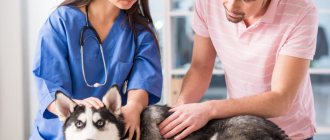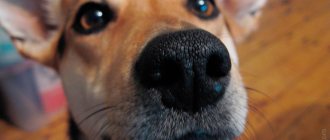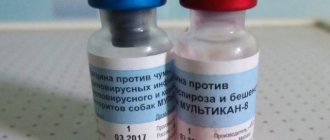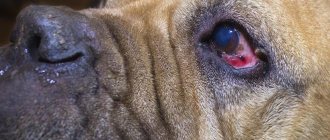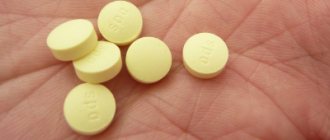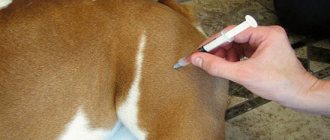Dogs can be injured in various ways: scratched by protruding branches, plant thorns, dry grass, cut by glass or other sharp objects, and damaged paws when jumping. Dogs often fight among themselves, they can be severely scratched and even bitten by cats. Fold-eared breeds with large, “fleshy” ears especially suffer in fights. Another cause of injury is an accident when a dog is run over or hit by a car.
In case of severe injuries, if the bleeding does not stop, or there are large surface defects that require suturing of the skin, it is necessary to quickly take the animal to the veterinarian, otherwise the consequences can be very sad.
If the right decision is not made in time and treatment is not started, the wound may become inflamed and fester. Coping with such a situation will be much more difficult, and the injury may be complicated by blood poisoning.
Types of wounds in dogs
The most common types of wounds in domestic dogs are:
- Abrasions and scratches. They can occur either when the animal touches various objects and plants, or due to the fact that the pets scratch themselves too vigorously. It happens that a dog gets injured when it bites off fleas or tries to get rid of tangles or matted fur.
- Cuts. They can appear after contact with sharp objects; it happens that the dog cuts its mouth on the sharp ends of a chewed bone.
- Bites from other dogs, cats and other animals. Such wounds most often tend to fester, since their surface is initially contaminated with secretions from the aggressor’s mouth.
- Splinters. They can get into the paw when the animal is running on the street or in the yard, but it happens that the splinters have to be removed from the dog’s tongue or cheeks if he likes pieces of wood or, for example, chews on the owner’s sofa or armchair.
- Injuries resulting from beatings or being involved in an accident. Typically, such situations result in the most complex and life-threatening injuries to the animal.
Treatment at home is only possible if the dog has suffered superficial injuries that are not life-threatening.
What to do if the wound does not heal
Superficial and uncomplicated injuries most often heal in a maximum of 2 weeks, but crushed, lacerated and infected injuries can take much longer to heal.
However, if the damaged area takes a long time to recover, then it is necessary to urgently seek help from a veterinarian. A specialist will examine the damage and will likely refer the owner and his dog to a surgeon. The operation will consist of surgical intervention with excision of the edges.
Important! If the dog has a wound on the nose or the neck is injured, then urgent consultation with a veterinarian is required.
If the wound does not heal and festers, it is necessary to take the animal to a specialist as soon as possible
When to see a veterinarian
- If the dog is bitten by another animal, there is no way to do without a veterinarian. The animal that caused the injury may be sick or rabid, and this threatens not only the death of the pet, but also infection of family members and other innocent people with a fatal disease.
- Urgent assistance from a veterinarian is necessary if the animal is severely injured, for example, by a fall from a height, hit by a car, has a gunshot or knife wound, beaten, or there is a suspicion of fractures and bruises of internal organs. In such a situation, minutes often count.
- Bleeding from a wound that cannot be stopped also requires veterinary attention.
- Rescue of a dog with an extensive wound on the head can only be organized in a well-equipped clinic, as there may be areas of scalping of the skull, concussion, and damage to the skull. Such injuries need to be accurately diagnosed and treated in a veterinary hospital, as the wounds will need to be sutured, plaster and bandages applied to fractures, and special treatments and strong medications used.
Wounds of the skin and underlying tissues without penetration into cavities and organs can be treated at home.
Emergency care for abdominal wounds.
With large abdominal wounds, the dog often experiences intestinal prolapse. And if the intestines are not damaged, then the dog can be saved.
Help consists of washing the prolapsed intestinal loops with a 0.1% solution of rivanol, furatsilin; when you don’t have them on hand, you can use boiled water. Then, using a clean cloth (towel, gauze, sheet) pre-moistened with a solution of furatsilin, rivanol is carefully inserted through the wound opening into the abdominal cavity. We apply a bandage to the wound and take the dog to the veterinary clinic as quickly as possible.
Treatment of fresh superficial wounds
Treatment of a wound in a dog has its own characteristics and must be performed according to certain rules. We must assume that the dog’s wound may be contaminated with its own hair, so first of all, the hair on the affected area should be trimmed and, if possible, shaved so that during treatment the hairs do not get into the wound. This is done to prevent infection from the fur from getting into the open wound.
As soon as the “surgical field” is cleared, the wound must be disinfected. A small abrasion is not dangerous if it is immediately disinfected by treating it with a disinfectant solution. An extensive defect is handled differently. First, the periphery of the wound is cleaned of possible contamination, and then only the wounded area itself is washed. Do not pour alcohol, iodine or brilliant green onto the damaged area, especially if a large area is damaged. The animal will be in great pain, it will begin to break free, it may bite the owner and stop trusting him. It will be very difficult to treat it in the future; there will actually be a chemical burn at the wound site, it will heal slowly, and then a scar will form on which hair will not grow. It is best to rinse with a 3% hydrogen peroxide solution. This is an excellent remedy to quickly heal wounds. If they are small and “clean”, additional exposure and disinfectant ointment may not even be necessary. If the ear wound has become infected, it should be treated at home as quickly as possible before the infection spreads. They also clean the wound of pus with hydrogen peroxide, and then use Levomekol wound healing ointment. It is easiest to inject it into hard-to-reach places using a syringe without a needle. It is best to use rinsing and ointment twice a day; if the wound is extensive and very suppurated, then treatment can be done more often.
Ointment is also applied to minor injuries in the ear area, making sure that it does not get into the animal’s eyes and mouth.
Assessment of the situation and first actions
During walks, pets can often injure or scratch their paw by stepping on a dry branch or glass. In this case, there is no need to panic. The wound should be cleaned of dirt by rinsing with cold water, the hair around the wound should be trimmed, and the area should be treated with hydrogen peroxide. It will disinfect, remove remaining dirt and stop bleeding if it is not very severe.
After this, you can wash the damage with Furacilin solution. He will further disinfect the wound. The solution is applied to a cotton swab and applied to the wound.
Once you have cleaned the wound, you can assess the depth and width of the cut. If it is not deep and no more than 2 cm wide, then you can do without stitches. If the wound is deep and widely dissected, then you need to resort to the services of a surgeon.
The most vulnerable spot in a dog is its paw. After treating the wound, its edges need to be brought tightly together, apply an adhesive plaster and a fixing bandage. If the bleeding does not stop, you can press a cotton swab soaked in hydrogen peroxide tightly to the wound and bandage it.
In order for the wound surface to heal quickly, it should be irrigated with Chlorhexidine 2-3 times a day. To do this, take the product into a syringe with a needle and pour the solution onto the wound. After this, treat the edges of the wound surface with hydrogen peroxide. And so continue until the surface is covered.
If the wounds are deeper, then ointments should be applied during the treatment: Levomekol, Streptomycin. Change the bandage at least 2-3 times a day.
Carefully monitor the animal and do not allow it to lick the injury, as an infection may occur and the wound surface will take a long time to heal. Of course, it will not be easy to explain this to the dog, but you can use a special surgical collar, which is easy to purchase at the pharmacy.
When going outside, you should wear a polyethylene sock and wrap your foot like a footcloth. If you do all the procedures, the wound will heal in 2-3 weeks.
We recommend this article:
The main symptoms and dangerous consequences of a tick bite in dogs
How to treat deep and festering wounds
Often, saving a dog with a large wound on the head or body depends on the speed of contacting a veterinarian. The wound surface is covered with sterile material and the animal is transported to the clinic. The doctor must be informed how the cut was treated and what means the dog was treated with.
If the situation is not so critical, for example, the dog has severely injured its paw with sharp grass, and a fairly deep cut has festered, you need to follow certain rules. Festering wounds are not sutured, even if the pet owner has such skill. First you need to clean the wound. To do this, dried crusts are soaked in peroxide, removed with sterile gauze, the wound is opened and the pus is removed. Then an ointment or other preparation with healing properties is applied to the entire surface. In order for the wound to heal, a sterile bandage is applied to it, and a special “collar” is put on the pet’s head, which will not allow it to tear off the bandages and lick the damaged areas.
Cuts and scratches on the ears after cleaning using these methods do not need to be lubricated with ointment, but sprinkled with streptocide; they will quickly dry out and become crusty.
IMPORTANT: If dangerous symptoms of rising temperature, convulsions, lethargy, or loss of appetite appear, the dog should be taken to the veterinarian. Most likely, he will recommend specific antibiotics and other medications that are selected individually.
In case of any serious injury, a quick trip to the veterinarian can save the life of the entire family pet, so in difficult cases, do not take risks and seek help immediately.
First aid for a dog
If you notice any defects on the dog’s body (wounds, bite marks, cuts), carefully examine the animal. Assess the extent of the damage and the condition of the pet, then provide assistance or take the pet to the clinic.
Shallow superficial wounds
With this type of wound, treatment can be carried out independently.:
- Carefully trim the hair around the wound and the bruised area with sterile scissors (boil or treat the instrument with alcohol).
- Wash the wound well with an antiseptic to avoid infection. Use peroxide, rivanol.
- Blot off excess antiseptic with a cotton-gauze pad.
- Cover the wound surface with a sterile bandage.
- To speed up healing, lubricate the wound with brilliant green the next day.
To prevent your dog from licking or gnawing on the wound, wear a protective plastic collar.
Deep lacerations, puncture wounds without contamination
Treatment of such wounds involves the following steps::
How can you clean an open wound?
If your dog has an open wound, you should first contact your veterinarian for advice before attempting to clean it. If you are unable to take your pet to the vet, you may be advised to clean the wound at home. The best solution for this is saline solution (salt water). You can make a saline solution by dissolving salt in warm water (about 1 teaspoon per 500 ml). Ideally, try to use water that has been previously boiled or that is safe to drink. Avoid touching the area if possible and stop immediately if your dog shows any signs of irritability. Don't put yourself at risk of being bitten by your pet - his behavior may change when he feels pain. Even wounds that appear clean to begin with can become infected, so monitor the wound as advised by your veterinarian.
Features of a dog's diet after injury
After receiving an injury, which leads to destruction of the integrity of the skin, soft tissues, bones, nerves, tendons, blood and lymphatic vessels, processes begin to occur in the animal’s body aimed at stopping inflammation and regenerating the damage. Therefore, the dog quickly loses strength.
To avoid dehydration due to blood loss, the dog must have constant access to water.
To restore them and support the immune system, it is very important to provide your pet with adequate nutrition, along with which his body will receive all the necessary vitamins and beneficial microelements. In addition, it is necessary that he has constant access to clean water, because the injury is accompanied by blood loss, which requires restoration of the water balance.
Special first aid kit
Scratches are not a serious injury and the owner should be ready to immediately and independently provide first aid to his dog and properly care for him in the future. For such cases, you need a special first aid kit, which you should have not only at home, but also on the road with your dog, or on a long vacation.
To provide quick help for scratches, your first aid kit should contain:
- bandage,
- brilliant green,
- hydrogen peroxide,
- potassium permanganate,
- cotton wool,
- adhesive plaster,
- alcohol,
- Levomicol ointment,
- ointment "Rescuer"
- cream-balm “Ambulance”.
